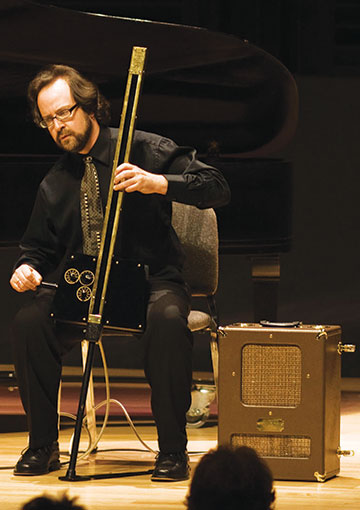Next story: Dancing in Jaffa
Messaging the Medium
by Jan Jezioro

Can the theremin be a “Medium to the Beyond”?
No, of course not—but, if you ever want to conjure up an aural representation of the Other Side, you can’t go wrong using a theremin, or a theremin cello, in this case, to get an audience into the kind of mental state where they may well start imaging spectral manifestations.
On Friday, May 2 at 4pm, the final event in this academic year’s UB Humanities Institute’s Scholars @ Hallwalls series, under the guidance of the institute’s director Erik Seeman, will feature current research fellow Jonathan Golove, UB professor of cello, in the premiere of his new composition, Mental Radio, for theremin cello, voices, and instrumental ensemble.
What exactly is the theremin cello? Here is the backstory:
“I came to the project of learning to play the theremin cello for a performance of Edgar Varese’s Ecuatorial at the University at Buffalo in 2002,” says Golove, “the first time the work was heard with the instrument for which it had been conceived since its 1934 premiere. Ecuatorial is the only known composition for the theremin cello, before my work that I will be premiering at this event. There were three points of contact: David Felder, artistic director of the Slee Sinfonietta, who had programmed the work; Olivia Mathis, a musicologist and scholar of both Varese and Theremin; and Floyd Engels, who had built beautiful replicas of this long-forgotten instrument, the first electric instrument to make use of the playing techniques of the bowed string family.
“In the project’s background were Robert Moog, the great updater and popularizer of the space-controlled theremin, and Albert Glinsky, who wrote the book on Theremin—literally. As a modern player of both acoustic and electric cello, I was intrigued by the challenge and, as an admirer of Varese’s music, delighted that I would have the possibility to play a soloist role in a great work by this master who wrote so infrequently for strings.
“The theremin cello represents one of the early applications of electronic technology to musical instruments,” says Golove, “and while Leon Theremin’s instruments, though fiendishly difficult to master, are extraordinarily simple to play, they thus represent a democratization of musical means of production. To observers in the 1920s and 1930s, they appeared to be magical; for their inventor, they also provided a tool for measuring basic musical aptitudes. Mental Radio is an original musical-dramatic realization of Upton Sinclair’s 1930 book Mental Radio: Does it work, and how?, in which the author recounts his attempts to test and verify what he believed to be his wife’s natural psychic abilities.”
It is something of a surprise to discover that the hardboiled reporter Upton Sinclair, who achieved his well-earned fame through muckraking novels such as The Jungle, which exposed the horrors of the meatpacking industry in 1905 Chicago, would have taken the possibilities of spiritualism seriously enough to devote a book to exploring its validity. Sinclair explored spiritualism because of his second wife’s interest in this pseudo-science, putting one in mind of the words of the old 1970s song: “The Things We Do for Love.”
“Working with the theremin cello with some amazing collaborators has been a great adventure for me,” says Golove. “My fellows in Mental Radio are Joe Rozler, vocals and analog synthesizers; Ana Vafai, vocals and violin; and Bill Sack, electric guitar and diverse electronic devices of his own invention. I’ve continued to collaborate with Floyd Engels on the instrument, and he has been incredibly responsive to every new problem and demand I’ve brought to him.”
Admission to the event is free, and a discussion of the instrument and composition will follow the performance.
Buffalo Chamber Players
Hot on the heels of their sold-out concert last week at the Buffalo Seminary, the Buffalo Chamber Players head just a bit north for their next gig at 8:30pm tomorrow (May 2), as part of the First Fridays @ The Gallery series at the Albright Knox. Their lecture/concert is titled Great Expectations: Nationalism and Cultural Identity and features selections, both familiar and not, from 19th- and 20th-century composers.
The European portion of the program features movements from Brahms’s String Quintet in G Major, Op. 111, Dvorak’s String Quartet No. 12, Op. 96 “American”, and Ravel’s String Quartet, while the North American portion of the program features Aaron Copland’s complete Quartet for Piano and Strings and Mexican composer Silvestre Revueltas’s Ocho Por Radio. The not-to-be-missed clincher for this program is the rare opportunity to hear Alexander Glenfield, the Buffalo-based, American virtuoso of Tuvan throat-singing, a vocal style unique to the borderlands of Russia and Mongolia that must be experienced in person to be believed, perform his Echoes of Derinkuyu.
Admission is free for gallery members, $5 for non-members.
blog comments powered by Disqus|
Issue Navigation> Issue Index > v13n18 (Week of Thursday, May 1) > Messaging the Medium This Week's Issue • Artvoice Daily • Artvoice TV • Events Calendar • Classifieds |









 Current Issue
Current Issue